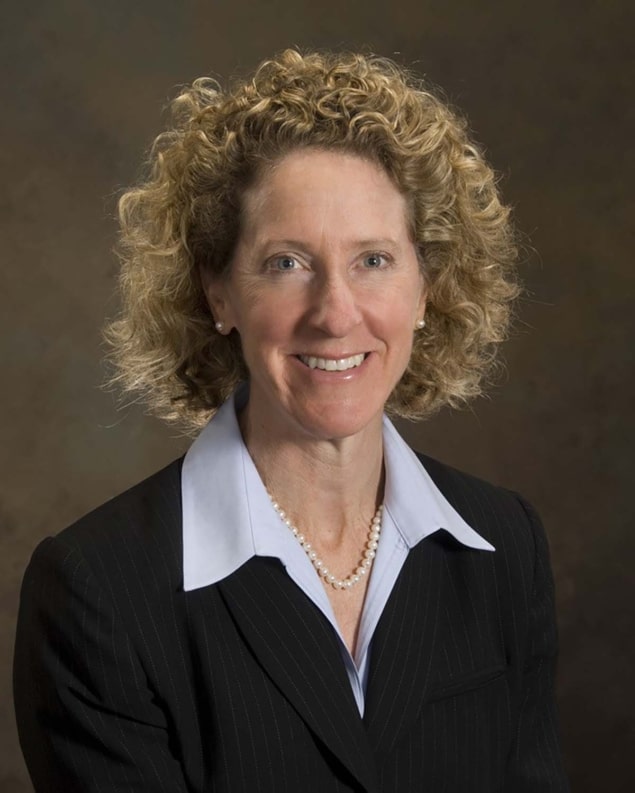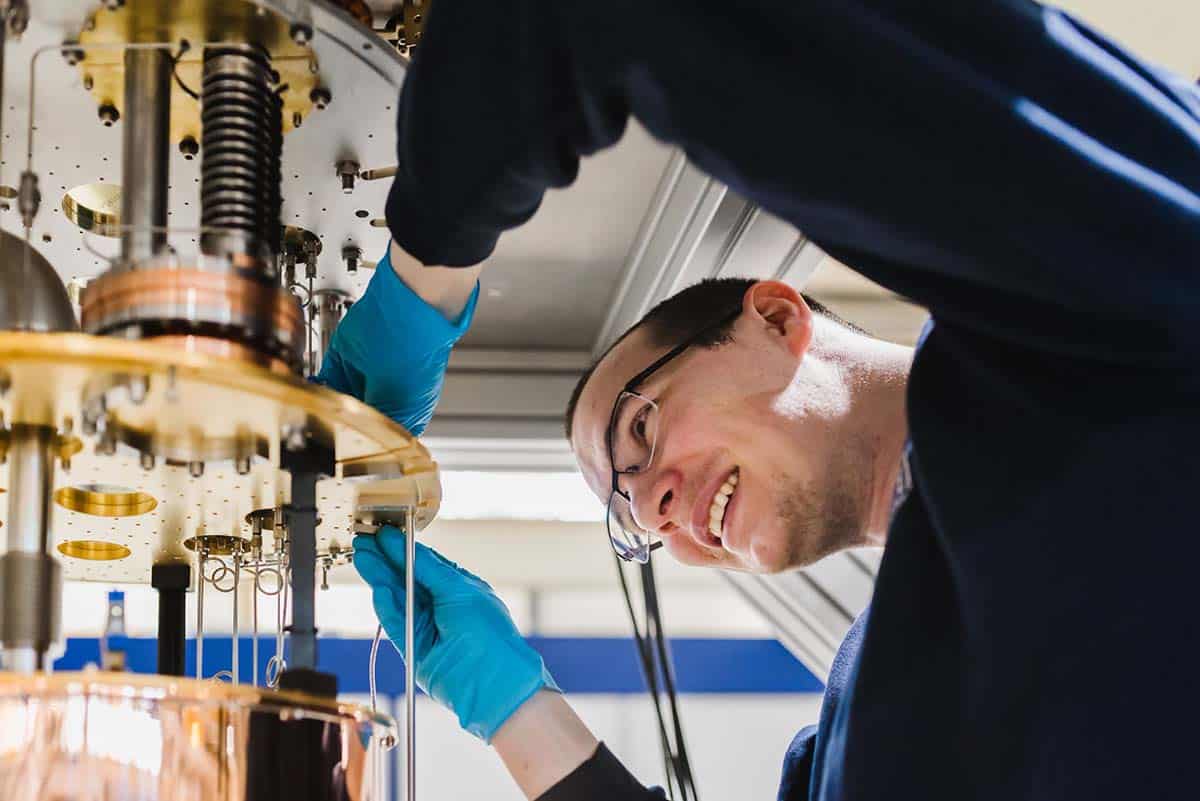The mission of the US Quantum Economic Development Consortium (QED-C) is to enable and grow a robust quantum-based industry and supply chain. Executive director Celia Merzbacher tells Hamish Johnston how QED-C addresses gaps in quantum-related technologies and workforce capacity by encouraging collaboration between government, research and industry

Why is it important for the US and other countries to have a national strategy for quantum science and technology?
Quantum sensing, quantum networking and quantum computing technologies hold significant promise for improving national security, but also for their long-term economic and societal impacts. However, the field is still at a relatively early stage in terms of technology evolution. There’s a clear requirement for advances in fundamental science, an activity supported by government funding in the main. It’s also worth noting that quantum is what I call a “multi-type” endeavour. It’s multidisciplinary, multiagency (in terms of government support), multisector and multinational. As such, progress will be accelerated through strategic, cross-cutting and coordinated investments in a broad research portfolio.
How should countries balance their national security requirements with the need for international collaboration and global supply chains in quantum technology?
It’s understandable that national interests should play a role in controlling the flow of information in certain sensitive quantum use-cases – though, ultimately, any restrictions need to be implemented carefully and in partnership between like-minded countries. Right now, it feels premature to be overly restrictive. There’s a broad understanding of the need for open sharing of information, R&D opportunities and science/engineering talent to encourage multidisciplinary collaboration between centres of excellence all over the world.
How well positioned is the current US effort in quantum science and technology?
Looked at from an input perspective, the US is faring well, with government investment in quantum R&D for 2022 running at around $900m – and compared with an aggregate per-annum global spend on quantum across government and private sector estimated at approximately $30bn. In terms of outputs as well, the US is shaping up competitively, registering the largest numbers of highly cited, high-impact scientific publications along with China.
Is there a danger of too much hype damaging the reputation of the quantum industry?
This is a key question and one that crops up often. There’s certainly a lot of excitement and interest around the quantum sector, with growing levels of public and private-sector investment. Here at QED-C, we don’t see evidence of what might be called a “bubble” – just researchers and companies within the emerging supply chain reporting steady progress on their development roadmaps while addressing a lot of tough technology and engineering problems along the way. In fact, organizations like QED-C have a significant role to play here in managing expectations. Chiefly, that means sharing credible, evidence-based data and metrics on progress so that diverse stakeholders – policy-makers, funding agencies, the investment community and industry – have a granular understanding of the state-of-the-art and where quantum technology is heading.
There’s an acknowledged shortage of skilled workers in the quantum workforce worldwide. What skills are needed to bridge the gap?
There’s a misconception that workers need to have a PhD – preferably in physics – to enter this field. That’s absolutely not the case. Manufacturers and developers within the early-stage quantum supply chain are desperate for scientists, engineers and technicians – especially those with experience in a related field – for example, cryogenics, test and measurement, data science or circuit design. What’s more, with targeted training and staff development, it’s possible for mid-career professionals in related disciplines to pivot into a career in the quantum industry (see “Quantum technicians: scaling the talent pipeline”, below).
One thing is clear: the quantum sector is brimming with opportunity for ambitious individuals, with a range of skills needed within hardware companies, software companies and, ultimately, the end-users of quantum technologies in key verticals like pharma, finance and healthcare. We also need commercially minded technical sales people who understand how to fuel the nascent market for quantum applications. In this way, the quantum industry offers all sorts of pathways for talented scientists and engineers to evolve from mainstream technical roles into business development activities if they choose.
Quantum technicians: scaling the talent pipeline for industry
While efforts are underway to prepare students at the undergraduate, masters and PhD level for quantum engineering and scientist roles, there are few associate degree and specialist vocational education programmes geared specifically towards the training of “quantum technicians”. That’s the main take-away from Guide to Building a Quantum Technician Workforce, a new study from QED-C, a consortium of US and international stakeholders that aims to fast-track growth across the quantum industry supply chain.
Quantum technicians fulfil many key functions in quantum technology companies, including system and component fabrication, device assembly, characterization, testing, operation and maintenance. What’s more, notes the report, demand for skilled technicians “is expected to grow as the industry continues its rapid development”, with a pressing need to scale this section of the workforce in the near term.
A range of specialist domain knowledge and skills are commonly required for quantum technician roles – including experience with vacuum, cryogenic and optical systems, as well as programming and soft skills. Current hiring strategies often focus on recruiting candidates from adjacent technology sectors – microelectronics, semiconductor manufacturing and photonics among them – with in-house shadowing programmes to provide on-the-job training for new staff.
The QED-C report argues, however, for a “more coordinated approach specifically geared toward filling the quantum workforce pipeline” and, in turn, to increase productivity and commercial opportunities, especially within smaller companies.
Recommendations in the QED-C study include: defining the types of quantum technician roles and investing in marketing to build awareness about career trajectories; mapping of existing training programmes versus the knowledge, skills and abilities that quantum technicians need; and creating local partnerships between higher education, industry and the US National Laboratory system. The report also calls for the establishment of an accreditation programme for quantum technology curricula and extra cash for institutions focused on quantum training and education rather than research.
“Manufacturing of quantum systems has not yet scaled to high-volume production,” the report concludes. “As such, many assume that demand for quantum technicians is low or non-existent. This is a common misconception – in fact, quantum technician roles are highly relevant in the experimental and prototype stages.”
Guide to Building a Quantum Technician Workforce: Reskilling and Upskilling Recommendations to Prepare a Workforce of Quantum Technicians is available on an exclusive basis to members of QED-C.
QED-C was originally launched as a US initiative but has since opened its membership to organizations from 36 like-minded countries. What’s driven this shift?
Quantum R&D and technology innovation is happening on a global scale and certainly the US, at this time, does not have the sole leadership position or an enormous head-start. We recognized from the outset – along with our federal government sponsors – that international partnerships would ultimately be fundamental to the success of the QED-C mission. Equally, our members are looking at a global opportunity when it comes to markets, customers, technology partners and even investors. Helping our members succeed along those coordinates is what we try to do every day at QED-C.

How should industry and government approach R&D on quantum computing given that it’s unclear which platform technologies – superconducting circuits, ion traps, photonic processors or the like – will prove commercially viable?
For government, the focus is on precompetitive basic and applied research. That means prioritizing foundational hardware and software technologies, underpinned by theoretical understanding, experimental systems, device design and fabrication – and pushing along all of these research pathways simultaneously. On the industry side, meanwhile, companies across the supply chain need to progress as quickly as possible from the R&D lab towards sustainable revenues and long-run commercial applications.

Fermilab’s SQMS Center addresses all aspects of the ‘quantum puzzle’
Another area that needs to be strengthened is engagement with the end-users of quantum computing in all sorts of diverse industries – from quantitative finance and insurance to medicine, telecoms, advanced materials and the rest. Over time, there will be many more “quantum takers” than “quantum makers” and all those takers need to be setting up pathfinder teams now to figure out how their respective industries will be disrupted by quantum technologies.
Listen to the full interview on the Physics World podcast channel: “Quantum science and technology thrives when industry and governments join forces”.
- SEO Powered Content & PR Distribution. Get Amplified Today.
- PlatoData.Network Vertical Generative Ai. Empower Yourself. Access Here.
- PlatoAiStream. Web3 Intelligence. Knowledge Amplified. Access Here.
- PlatoESG. Carbon, CleanTech, Energy, Environment, Solar, Waste Management. Access Here.
- PlatoHealth. Biotech and Clinical Trials Intelligence. Access Here.
- Source: https://physicsworld.com/a/quantum-innovation-how-strategic-focus-can-turbocharge-the-technology-roadmap/



